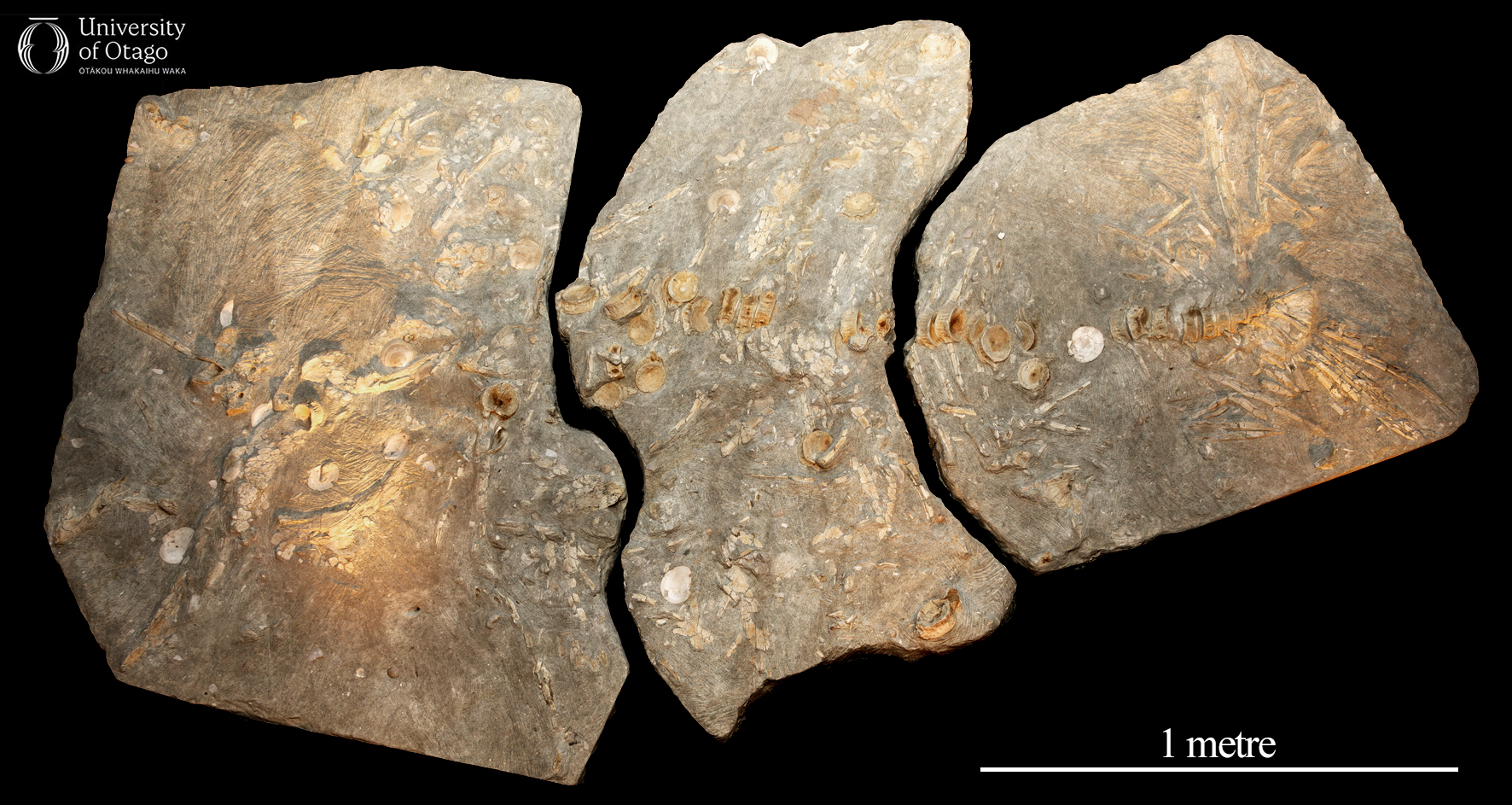7 Giant moonfish buried three layers deep
Osteichthyes, Lampriformes: Megalampris keyesi
The Waitaki Whitestone Global Geopark is celebrated for being the first United Nations Educational, Scientific and Cultural Organization (UNESCO) Global Geopark in New Zealand. The journey towards recognising this international landmark has its origins in the early partnerships formed between Ewan Fordyce, the Department of Geology, University of Otago, and local land owners and custodians. These partnerships began in the 1980s and 1990s when Ewan was developing his paleontology field programme across North Otago and South Canterbury. In the mid-1990s he visited the limestone bluffs of Island Cliff in the heart of the future UNESCO Global Geopark to search for ancient whales.

Bones from the giant moonfish Megalampris keyesi (specimen OU 22268). This fossil is currently on display at Tūhura Otago Museum in the Southern Land, Southern People gallery. Image credit: K Fleury. |
At this site, Ewan and his team discovered the best preserved example of a large fossil shark that had ever been found in Aotearoa New Zealand (read about this discovery here: Exceptional mega shark: distant ancestor of Jaws). Several blocks of limestone containing the fossil teeth and vertebrae were cut from the bluffs by a small team during the summer of 1995, and the blocks were encased in plaster jackets for transport back to the Geology Department. Upon peering into the pit resulting from the fossil excavation, the team discovered another fossil lying beneath the burial site of the fossil shark. This second specimen, the skull of an archaic dolphin, would later be studied by one of Ewan’s students. Peering back into the pit again after the dolphin skull had been removed, the team discovered yet another fossil. This third fossil would become the type specimen of Megalampris keyesi, the largest bony fish fossil ever discovered in Aotearoa New Zealand.
Megalampris keyesi is an extinct member of the Lampriformes order of bony fish. Living species within Lampriformes are characterised by an extremely elongate body: species like scalloped dealfish Zu elongatus, unicornfish Lophotus capellei and especially the oarfish Regalecus glesne are rarely seen around New Zealand. In contrast, the more oval-shaped moonfish, Lampris guttatus and opah Lampris immaculatus, are encountered more commonly in New Zealand waters. Moonfish prefer tropical to temperate waters and around New Zealand they have been found in surface waters down to 500 metres, reaching a full length of 200 centimetres.
Megalampris keyesi was twice as large as living moonfish at approximately four metres long. The fossil fish was collected in three limestone blocks that revealed bones from the skull all the way through to the tail. Large bones associated with the pectoral fins suggest that Megalampris keyesi moved by paddling through the water just like living moonfish. The giant fossil specimen was collected from sediments deposited in quiet waters along the middle to outer continental shelf, a similar environment to that inhabited by moonfish today. At the time of discovery Megalampris keyesi was the first fossil species within Lampriformes ever reported from the Southern Hemisphere. A possible second discovery may have been made in Raglan in the North Island of New Zealand, and has been investigated by Michael Gottfried, lead author on the study that described Megalampris keyesi.
The Island Cliff fossil locality within the UNESCO Waitaki Whitestone Global Geopark is now famous for producing both the best preserved large fossil shark and the largest fossil fish, both from the same spot.
—Written by Daniel B Thomas
| Specimen number: OU 22268 | Age: Approximately 26 million years old (late Oligocene, Duntroonian stage) |
| Locality: Tokarahi, North Otago | Rock Formation: Otekaike Limestone |
| Collected by: RE Fordyce, A Grebneff, B Black and associates | |
| Citation: Gottfried MD, Fordyce RE, Rust S. 2006. Megalampris keyesi, a giant moonfish (Teleostei, Lampridiformes) from the Late Oligocene of New Zealand. Journal of Vertebrate Paleontology 26:544–551. doi:10.1671/0272-4634(2006)26[544:MKAGM | |
Geographical areas with geology of outstanding societal value, which are community owned and open to everyone. See: UNESCO Global Geoparks Programme.
A sedimentary rock composed mainly of calcium carbonate. Can be formed from the skeletal fragments of marine organisms.
The series of bones forming the flexible 'backbone' structure of the animals named for possessing these bones, the vertebrates.
Protective coverings made of plaster used to encase and transport fossils.
The specimen on which the description and name of a new species is based.
The pair of fins located on either side of the body near the gills.
The extended margin of a continent which is submerged under relatively shallow seas. While the width of the shelf varies between continents, most shelf seas are generally less than 100 metres deep.

